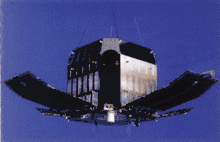Tenma
Tenma, known as ASTRO-B before launch (COSPAR 1983-011A, SATCAT 13829), was a Japanese X-ray astronomy satellite, developed by the Institute of Space and Astronautical Science. It was launched on February 20, 1983 using a M-3S rocket on the M-3S-3 mission.

Tenma (Japanese for "Pegasus").
Battery failure in July 1984 caused the operation to become limited, and continuing problems lead to the termination of X-ray observation in 1985. It reentered the atmosphere on January 19, 1989 (other sources, for example the NORAD catalog of satellites, say decay date was 17 December 1988[1]).
Highlights
- Discovery of the iron helium-like emission from the galactic ridge
- Iron line discovery and/or study in many LMXRB, HMXRB and AGN
- Discovery of an absorption line at 4 keV in the X1636-536 Burst spectra
gollark: The nether is safe from dynmap somehow too.
gollark: E!
gollark: <@151391317740486657> Are you satisfied with the potatOS potatolicense terms?
gollark: Random *public* service, obviously. I use it for potatOS.
gollark: All my databases are just this random cloud service which stores big JSON blobs.
See also

References
This article is issued from Wikipedia. The text is licensed under Creative Commons - Attribution - Sharealike. Additional terms may apply for the media files.